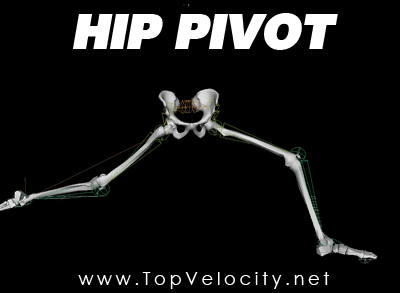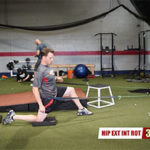 The majority of low-velocity pitchers who come through the 3X Velocity Camps have serious hip mobility issues. It is such an issue that I had to include an entire hip mobility training session to the camps. The reason is that it is almost impossible to train high-velocity pitching mechanics when the pitcher has hip mobility problems.
The majority of low-velocity pitchers who come through the 3X Velocity Camps have serious hip mobility issues. It is such an issue that I had to include an entire hip mobility training session to the camps. The reason is that it is almost impossible to train high-velocity pitching mechanics when the pitcher has hip mobility problems.
These hip mobility issues were always a major hurdle when training pitchers through the 3X Velocity Camp and for me in my own career. When searching for the key exercises to help remedy this issue, I did a ton of research on how these hip mobility restrictions can influence pitching velocity. I found several studies with evidence showing a link between hip mobility and pitching performance (1,2).
In this article, I will cover the key findings of hip mobility and there correlations to pitching velocity. I will also give you some basic knowledge of how to remedy your hip mobility issues and start supporting more transfer of energy from your lower kinetic chain into your upper kinetic chain.
Hip Mobility
When I talk about hip mobility, I am talking not only about flexibility but the ability to move through a full range of motion. If flexibility was all that mattered to the high-velocity pitcher then women would be the hardest throwers in the game. Power and Flexibility is the ultimate combination of the high velocity pitcher; you can't have one without the other. This is why I believe the Olympic Lifter is the ideal specimen for the developing pitcher. They can not only produce a ton of power but they can do it through a full range of motion. I have yet to find a sport that this type of training will not benefit.
The hips are the connector of the lower-to-upper kinetic chain. It is ideal for the elite athlete to have full functionality in this region. The hips are almost as malleable as the shoulders. The leg can move in multiple directions in the hip socket. The directions include; abduction to adduction and internal to external rotation. This means up and down and twisting back and forth. Studies show high-velocity pitchers have more of the ability to move the legs in all these directions within the hips (2). When developing the high-velocity pitcher it is critical that all hip mobility issues be remedied.
The Science Behind Hip Mobility and 3X Pitching
3X Pitching is built around a scientifically proven component of the high velocity pitcher and that is hip to shoulder separation. The 3X Pitching Velocity Program was developed for the main purpose of enhancing this key component. A popular debate around hip to shoulder separation is what creates hip to shoulder separation? Is it the shoulders or the hips? A recent study called, Passive ranges of motion of the hips and their relationship with pitching biomechanics and ball velocity in professional baseball pitchers, found that the hips are the primary mover of trunk rotation (2).
The hip has been demonstrated to be the primary joint initiating spinal rotation during trunk rotation. During the pitching motion, pelvic orientation and angular velocity influence torso (spine) rotation. During the stride and arm acceleration phases of the pitching motion, a rapid sequence of pelvic rotation followed by trunk rotation produces maximum upper torso angular velocity and maximum glenohumeral external rotation.
You can also have too much of a good thing. This study stated that too much hip rotation can be a bad thing. Specifically too much hip rotation too early.
Wright et al confirmed that hip rotation is correlated with foot-contact position and pelvic alignment. If an excessive amount of rotation occurs at the hips, then the pelvis and foot are in a more open position, thereby prematurely initiating the arm-cocking phase and resulting in the loss of kinetic energy from the lower extremity.
This means that arm cocking timing is as critical as hip rotation when it comes to supporting hip to shoulder separation. Too much hip rotation too early will disrupt this timing of the hips to shoulders and reduce pitching velocity.
The main purpose of this study, which was performed at the Connecticut Children’s Medical Center in Hartford, CT., was to link hip mobility to ball velocity. Here are the final results from the case study:
One hip passive range of motion (PROM) parameter (total arc of rotation) was significantly correlated with ball velocity. The biomechanical parameters found to have significant correlations with hip PROM were trunk separation velocity, pelvic orientation, and stride length.
Three hip PROM parameters (abduction (ABD) of the dominant hip, total arc of adduction (ADD) + ABD of the dominant hip, and total arc of rotation) correlated with trunk separation velocity. Total arc of ADD + ABD of the nondominant hip and total arc of rotation of the dominant hip both correlated with pelvic orientation.
This is proof that hip range of motion or full hip mobility is critical when it comes to pitching velocity. This is why it is critical for young pitchers to improve their hip mobility. It is also just as important for high velocity pitchers to maintaining this hip mobility because there is a high demand of force moving from the legs through the hips to increase ball velocity during the high velocity pitching delivery. This study states that hip mobility issues can continue to worsen even with the high velocity pitcher.
A force equal to approximately 1.75 times body weight is produced in the nondominant or lead leg, as it supports the pitcher and transfers energy to the trunk through this hip. Consequently, improper loading technique and inadequate muscular adaptations during the pitching motion may lead to hip maladaptations, resulting in a hindrance to pitching performance or ball velocity.
It is obviously after reading the key points defined in this case study that the high velocity pitcher must not only have optimal hip mobility but he must time the opening of his hips at the perfect moment along with having enough strength in the hips and legs to support this hip rotation and mobility. Here is an excerpt from the study talking about these factors in conclusion to the results of the study:
Pitchers require adequate hip rotation, ABD flexibility, and PROM to ensure proper pitching mechanics. Hip ABD strength appears important in maintaining hip ABD PROM, as suggested by previous authors who correlated a lack of PROM to weakness in the hip musculature.
Healthy professional pitchers possess less PROM in the non-dominant hip compared with the dominant hip. This difference would suggest a femoroacetabular rotational deficit. This study demonstrated that less PROM in the nondominant hip correlated with ball velocity and biomechanical parameters among professional pitchers. Thus, physical therapy and conditioning to regain hip PROM may help the professional pitcher optimize mechanics and ball velocity.
Another recent study called, Adolescent baseball pitching technique: lower extremity biomechanics analysis, analyzed the lower extremity biomechanics of adolescent pitchers in comparison to adult pitchers and also found the high demand of hip mobility and its correlation to increased pitching velocity (1). They also discovered that poor hip mobility can lead to what is called "hyperangulation" or what conventional coaches will call "arm drag." Here is an excerpt from this study talking about this discovery:
Peak hip extension of the trailing leg at approximately 39% of the pitch cycle and peak hip abduction of the trailing leg at foot contact are close to the typical maximum range of motion of the hip joint according to the normals tested in our laboratory. In the sagittal plane, limited maximum hip extension may lead to compensatory lordosis as the pelvis is pulled into an anterior tilt to accommodate the forward rotation of the thigh segment. This would begin the change of events leading to the “hyperangulation” and increased glenohumeral external rotation described by Sisto and Jobe (1986).
The pitchers who I have worked with who have this "hyperangulation" have had great results improving their arm path and arm speeds by first addressing their hip mobility issues. The reason is that the hips is the connector of the lower to upper kinetic chain as stated also in this case study.
Weakness and inflexibility in the hips have been implicated as a potential area for a break in the kinetic chain in the pitching cycle (Burkhart et al., 2003).
Not only does poor hip mobility lead to "arm drag" but it also can reduce stride length as stated here in the study.
In the coronal plane, limited hip abduction when the same hip is near full extension may result in reduced step length and associated reduction in performance. This is suggested by Robb et al. who found a high correlation between trailing limb passive hip abduction range and stride length (r = .70, p < 003) (Robb et al., 2010).
Studies have linked increased stride length to increased ball velocity (3). This study also linked the importance of lower extremity strength to improved performance.
The inability to achieve greater knee extension at ball release may be related to maturation, level of experience, and lower extremity strength.
If you have played this game for more than a few times you will have a good understanding of the importance of the hips. The problem is most pitchers have no idea how to improve the ability to use them. Here are some hip mobility exercises to get you started.
3X 90+mph Mobility Course
 This course will cover 3X Mobility Training to develop the High Velocity Pitcher. Most high velocity pitchers have elite level joint mobility which allows them the ability to get in the position to use the entire body or kinetic chain to generate 90+mph pitching velocity. Many of these pitchers genetically have this joint mobility but with the new science of today, we have discovered the process of unlocking these joints.
This course will cover 3X Mobility Training to develop the High Velocity Pitcher. Most high velocity pitchers have elite level joint mobility which allows them the ability to get in the position to use the entire body or kinetic chain to generate 90+mph pitching velocity. Many of these pitchers genetically have this joint mobility but with the new science of today, we have discovered the process of unlocking these joints.
This course was built for those pitchers who do not have the genetic joint mobility profile of a high velocity pitcher and want the ability to develop it. You will first learn what ranges all of the joints must be able to accomplish and then you will be given a full list of exercises to improve them.
Here is the list of joint ranges we will be measuring and working to improve:
- Dorsiflexion
- Plantar Flexion
- Hip Internal Rotation
- Hip External Rotation
- Hip Flexion
- Hip Extension
- Hip Abduction
- Trunk Rotation
- Trunk Extension
- Shoulder Flexion
- Shoulder External Rotation
- Shoulder Internal Rotation
Once you have these ranges recorded you compare them to the joint mobility ranges of the high velocity pitcher to learn where you need to make improvements. You will then follow the list of exercises in the following videos to improve these ranges.
These exercises include:
- Foam Rolling
- Mashing
- Static Stretching
- Banded Distraction
- Muscle Activation
Once the routine is established about 30 minutes to an hour a day then the process is to repeat measuring to see what joints are improving and what joints are not to shift focus into another cycle of training. This process over time will develop the joint ranges of the high-velocity pitcher.
Gain a cutting edge on this game before anyone else does and start this 3X Pitching Mobility Course TODAY!
Reference:
- Milewski MD, Õunpuu S, Solomito M, Westwell M, Nissen CW. - Adolescent baseball pitching technique: lower extremity biomechanical analysis. - Connecticut Children's Medical Center, Hartford, CT, USA. - J Appl Biomech. 2012 Nov;28(5):491-501.
- Robb AJ, Fleisig G, Wilk K, Macrina L, Bolt B, Pajaczkowski J. - Passive ranges of motion of the hips and their relationship with pitching biomechanics and ball velocity in professional baseball pitchers. - Canadian Memorial Chiropractic College, Toronto, Ontario, Canada. - Am J Sports Med. 2010 Dec;38(12):2487-93.
- Rod Whiteley, University of Sydney, Australia. - Baseball throwing mechanics as they relate to pathology and performance – A review. ©Journal of Sports Science and Medicine (2007) 6, 1-20.


Trackbacks/Pingbacks